We have finally made it -- 615 picks in the 2024 Draft, 615 scouting reports.
The goal?: To see 90 percent of the players drafted this year featured on this board. Last year we got close with roughly 87 percent of the 613 players selected being featured on the final board.
It's always nice to file another year into the 'final draft' category. I hope you've enjoyed the ride as much as I have.
Building out a draft board is a complicated exercise. Our process involves meticulous detail in batted-ball data evaluation, pitch decision tracking, pitch design metrics, athletic testing, and one-on-one interactions with the players and their coaches as we work to get a feel for their makeup. In fact, many of the players you'll find in the 400-600 range are exclusively identified by their metrics and developmental upside as it pertains to uniqueness.
We attend tournaments, showcases, scrimmages, and games to watch the players in their element. The whole process is complimented by extensive conversations with scouting directors, analysts, cross-checkers, and area scouts to double-check our evaluations with differing opinions to help draw more conclusive ideas.
This update includes a stock watch feature. Any player who has moved up the board by at least 15 spots (half a round) will be highlighted as such next to their name.
EDITOR'S NOTE: The following rankings and evaluations by FSS PLUS are based on subjective analysis and industry sources, and do not influence, are not influenced by or are affiliated with the opinions and reports of Future Stars Series scouting and development staff.
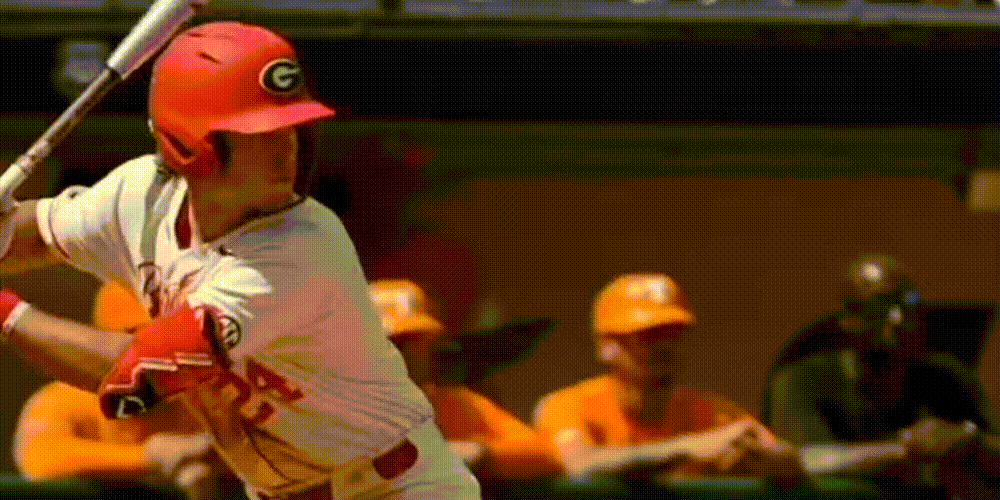
1. Charlie Condon, 3B/OF -- Georgia
HOMETOWN: Marietta, GA
HEIGHT: 6-6
WEIGHT: 216
BAT/THROW: R-R
DRAFT SPOTLIGHT INTERVIEW: Watch video
Condon's emergence for the Bulldogs in 2023 came as a bit of a surprise to the college baseball world after the long, lanky outfielder redshirted in 2022 to add weight and work on his swing. It's a similar player arch to former Florida outfielder Wyatt Langford, and Condon could be following in his footsteps.
Condon broke through as the regular left fielder for the Bulldogs last year and immediately provided impact with the bat. He's moving around the field at different positions this spring, but the bat is what ultimately catches the headlines.
He's got double-plus raw power and a hit tool that has continued to improve at the University of Georgia. The swing can get a little long at times, and there are some questions on his ability to make enough contact on pitches outside of the strike zone to be a truly consistent pure hitter at the next level. That's to be expected of a 6-foot-6-inch frame.
The levers are long and the path to the baseball will always be more complicated than his peers. Few doubt the impact in the overall offensive profile, even if he may have some small holes in his offensive game at the next level.
He may only possess a solid-average hit tool when all is said and done, but there's 40-homer upside.
Condon has received mixed reviews on his defensive ability, though just about everyone who's laid eyes on him this spring agrees the glove has taken a step in the right direction. He's received a ton of time at third base this year and has showcased at least average athleticism with strong situational awareness and some flair for the highlight reel play. It's still a huge frame that might have trouble playing low enough to the ground to stay at the hot corner long-term, but there's a chance.
His arm strength is stronger on the dirt than in the outfield receiving above-average grades from scouts featuring carry across the diamond. He's moving better than he once did, and the arm is plenty strong enough to warrant consideration in right field as a pro with some considering that his most likely future home.
Condon has the makings of a right-right power-hitting outfielder or third baseman. If Condon's defensive home and athletic prowess get settled as July approaches, he's as good a bet as anyone to go No. 1 in the Draft. There have been Kris Bryant and Nick Castellanos comps thrown on Condon this year.

2. Travis Bazzana, 2B -- Oregon State
HOMETOWN: Sydney, Australia
HEIGHT: 6-0
WEIGHT: 199
BAT/THROW: L-R
DRAFT SPOTLIGHT INTERVIEW: Watch video
You'd be hard-pressed to find a prospect with a better combination of pure hit tool, approach, and peak exit velocities than Travis Bazzana. An import out of Australia, Bazzana possesses plus bat-to-ball skills to go alongside his elite eye. He refuses to expand the zone and has shown a willingness to all fields. He's also about as good as they come in terms of pummeling balls left in the strike zone. He's one of the more decorated hitters in college baseball in terms of fighting off pitches just off the black.
A brutally difficult at-bat for opposing pitchers. Bazzana has flashed plus raw power, and he's getting to a lot of it in games. Bazzana has also upped his efficiency and production against left-handed pitchers this season posting blistering batted-ball data and the same mature approach he showcases against right-handed pitchers. This is a reasonably complete hitter.
An import out of Sydney, Bazzana was a star in the Pac-12 immediately as a true freshman. The Aussie has some twitch and clean actions on the dirt with fringy arm strength and enough athleticism to make the plays to his right and left. He makes all the routine plays despite lacking the natural range necessary for the highlight reel plays.
Some scouts want to see what it looks like over an extended period at shortstop, and whether the arm strength would play up from the left side, but that opportunity has yet to truly present itself.
Some think his profile ends up in center field or left field at the next level. He projects a potential plus hitter with above-average power, all while playing a steady second base.
He also has the potential to steal upwards of 20 bags per season as his high IQ and above-average speed should both impact the game immediately on the base paths.
Perhaps Bazzana's greatest strength however is tireless pursuit of perfection and improvement in his game. He's an analytic mind who welcomes developing his game through tangible numbers and data evaluation.
The kid grinds. His approach toward the game is already well-suited for the next level, and many believe his game should translate quickly to professional ball. He's got a shot at developing into someone with Marcus Semien production with a potential Jason Kipnis floor at the next level.
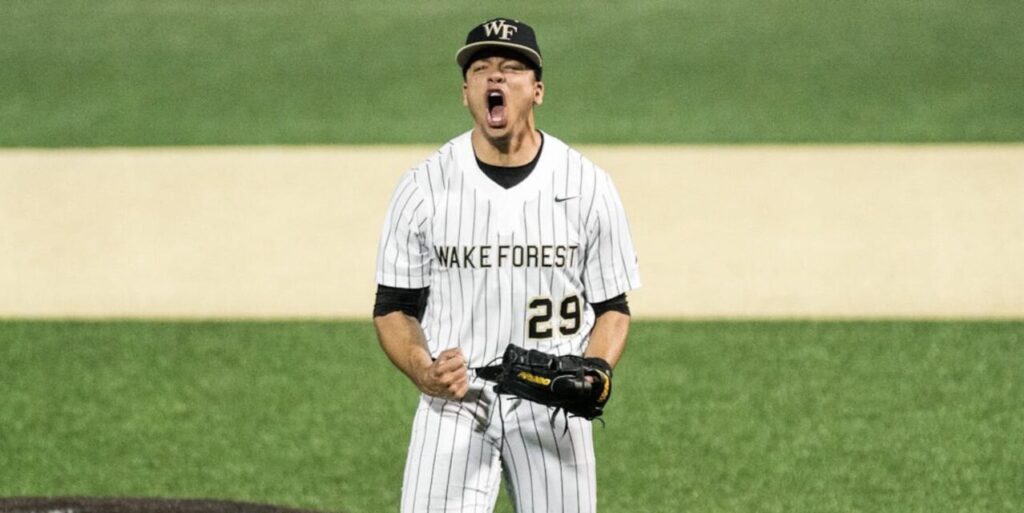
3. Chase Burns, RHP -- Wake Forest
HOMETOWN: Gallatin, TN
HEIGHT: 6-4
WEIGHT: 215
DRAFT SPOTLIGHT INTERVIEW: Watch video
Burns has long been on the radar of scouts going back to his days as a blue-chip prep in 2021. Primarily a two-pitch guy entering 2024, Burns added a devastating changeup and curveball to his arsenal when he can find feel for them in games. His one-two combo is almost always enough to put away the opposition, however.
Burns offers an upper 90s fastball that's touched 101 and figures to continue tickling triple digits as he matures. It features plus carry and Wake Forest helped develop natural cut to the pitch eliminating what arm-side tail he used to feature. It's a unicorn fastball with outlier shape and traits.
When Burns is on, and he's had contests where his pitch charts are awfully tight, it grades out as a double-plus heater and will likely have nights where it performs like an elite pitch. Burns' slider is thrown hard and firm, up to 92mph, sitting 89-90 with extreme two-plane tilt.
Burns' spin rates are high, and he's got a track record of controlling the strike zone and overpowering the opposition. It's every bit that of a 70-grade breaking ball. There's a seldom-used upper-80s changeup in his arsenal as well. Its shape compliments the fastball nicely and can be a real weapon against left-handed hitters.
There is a bigger curveball in there as well, a mid-80s firm hammer with more depth than sweep. The perfect tunnel off his fastball. It's got teeth but is often uncompetitive.
As he starts working in feel for his tertiary weapons the arsenal should continue to overwhelm hitters in ways college baseball seldom sees. The key word seems to be 'overwhelm". Scouts are still split on whether the strike quality at the next level will allow Burns to overpower hitters or whether his walk rates may rise as more advanced bats step into the box and see his stuff. Despite the low walk rates throughout his collegiate career, there remains a narrative in the industry of relief risk.
Burns spent the first two years in college at Tennessee before transferring to Wake Forest for 2024. He rotated between a rotation role and a high-leverage bullpen role.
The Wake Forest pitching lab should give him a leg up in understanding pitch design and how the art of the sport translates to the next level. This includes improving his overall pitchability and strategy toward going deeper into ballgames with his elite stuff. An emphasis on being more efficient out of the stretch is one area he could improve.
Burns simply looks like a front-line big-league arm and should be the first arm off the board to a team that believes and trusts he's a surefire starter going forward.
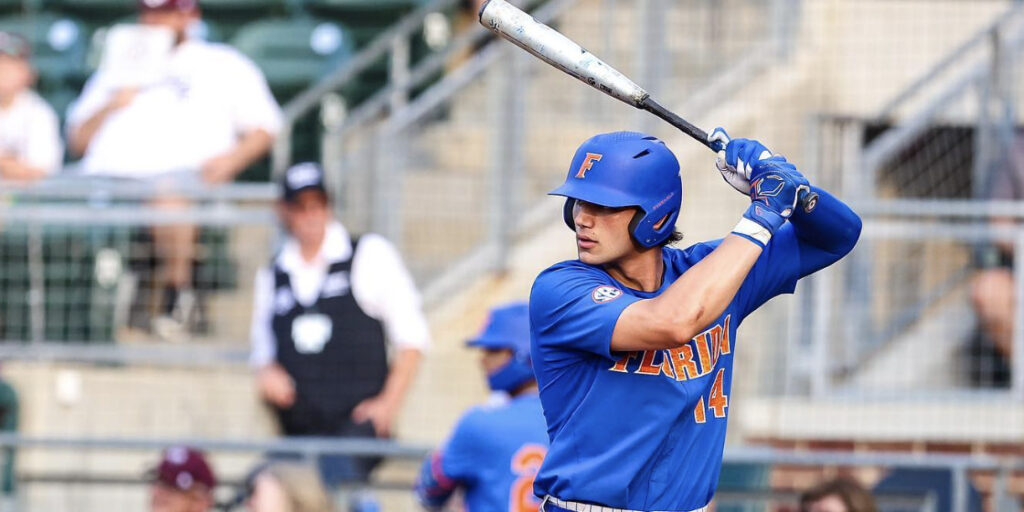
4. Jac Caglianone, 1B/LHP -- Florida
HOMETOWN: Tampa, FL
HEIGHT: 6-5
WEIGHT: 210
BAT/THROW: L-L
DRAFT SPOTLIGHT INTERVIEW: Watch video
Caglianone is possibly the most decorated and talented two-way player college baseball has seen in a very long time. Offensively he possesses immense hand and bat speed allowing the 6-foot-5-inch lefty to get into double-plus, possible elite raw power. He creates elite stretch and torque in the box with little to no question how the impact will translate to the next level.
Most scouts see plus bat-to-ball skills here, but Caglianone can get anxious at the plate and expand the zone at an unhealthy clip at times. That hasn't slowed his production as his adjustability allows him to get to pitches outside of the zone and make hard, solid contact. It's remarkable the barrel awareness considering the long levers.
There is still a slight hole in his swing when it comes to velocity at the top of the strike zone, and that could develop into a wart as a pro if Caglianone doesn't become more selective.
The hands and athleticism in the box have allowed the towering left-handed slugger to hold a strikeout rate near 10 percent all season. Truly remarkable considering his approach. Caglianone is a solid average runner and is likely destined for first base as a pro, but he's flashed above-average defense at the pillow and evaluators believe he'll be plenty comfortable at that spot full-time.
He's also a rangy defender who's shown spatial awareness tracking balls over his shoulder into foul territory. This is an impact bat with 40-home run upside and value on the dirt.
While most don't expect his future to be on the mound, Caglianone has been up to 101 in side sessions and 99 in games and will flash an above-average slider that's really come on of late. There's also a changeup, though it lags a bit behind his primary two-pitch mix.
Caglianone is a legitimate pitching prospect with No. 4 upside, though there is considerable reliever risk due to command concerns and his ability to repeat his operation deep into starts. He worked hard over the past twelve months to shorten his arm action and that seems to have paid dividends in his ability to control the ball. He's still very young and has plenty of time to shore up the polish and consistency of those mechanical necessities.
There are a multitude of avenues Caglianone can take to become a valuable and productive big leaguer. Which route he'll choose and which route scouts prefer for that matter is yet to be determined, though almost everyone points toward the offensive upside without hesitation. Caglianone has the chance to develop into one of the elite first basemen in the sport.
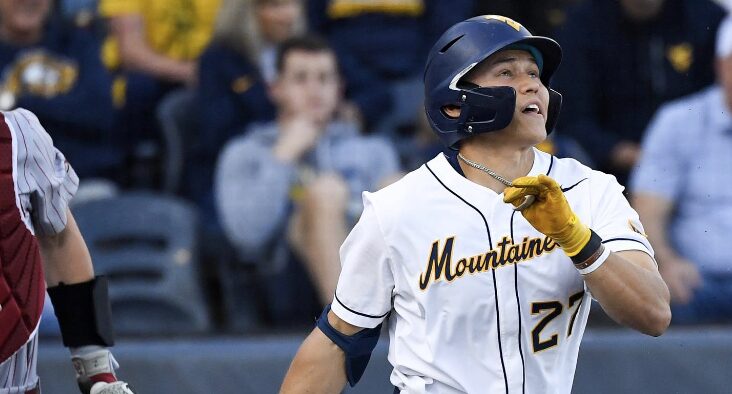
5. JJ Wetherholt, 2B/3B -- West Virginia
HOMETOWN: Gibsonia, PA
HEIGHT: 5-10
WEIGHT: 190
BAT/THROW: L-R
DRAFT SPOTLIGHT INTERVIEW: Watch video
Wetherholt, a twitchy, strong-bodied infielder, has positional versatility, though most consider him a second or third baseman in the long term. He received plenty of time at shortstop for the Mountaineers this season, though most scouts don't project it his future home. That said, he did flash some highlight reel plays this spring showing off above-average arm strength and sure-handed actions.
Wetherholt can handle the routine expectations anywhere on the dirt, though he may eventually outgrow the athleticism necessary to stick at the "6".
The bat is exceedingly impressive here. Wetherholt can really hit with double-plus bat-to-ball skills and a willingness to go gap-to-gap and stay away from the pull-heavy approach that gets so many lefty bats in trouble. The hand speed is exceptional with a barrel that stays through the zone a long time. There's some steepness to Wetherholt's swing that provides natural game power. The power and bat speed here are real, comfortably plus with barrel awareness few of his peers can match.
Wetherholt consistently hits the ball hard more than just about anyone in the country. On top of his tools in the batter's box, Wetherholt is also an above-average runner who gets strong jumps on the base paths. He's an aggressive, high-IQ player who figures to steal plenty of bags at the next level. While Wetherholt lacks much physical projection, his current level of play is representative of a player who could go No. 1 overall in any given draft regardless of physical upside.
Hamstring injuries have limited his ability to stay on the field at times and it's one of the reasons for apprehension on he playing shortstop 150 times per season. He did manage to play quite a few games at the position in 2024 and looked impressive in terms of range and first-step actions. But teams will have to consider the prolonged soft tissue woes. Should he stick at the '6', Wetherholt is capable of playing a David Fletcher-esque brand of defense with the glove. He'll make the occasional highlight reel play and everything routine will likely be gobbled up, but it may never look as smooth, natural, and fluid as many of his positional peers.
Considering his athleticism and track record, his resume with the bat should provide a floor inside the top ten picks even considering the risk associated.

6. Braden Montgomery, OF -- Texas A&M
HOMETOWN: Madison, MS
HEIGHT: 6-2
WEIGHT: 220
BAT/THROW: B-R
DRAFT SPOTLIGHT INTERVIEW: Watch video
Braden Montgomery is an absolute tool-shed with physical abilities very few in the 2024 class can match. He's been a stud prospect since his high school days, but signing a player away from a Stanford commitment always proves difficult. He's now at Texas A&M.
A two-way guy by nature, Montgomery likely best projects as a prototype right fielder with plus power, some calling it 70-grade raw, as well as above-average athleticism both on the base paths and in the field. He's shown tremendous barrel control, as well as a refined eye at the plate.
Montgomery is hitting the ball harder than ever before in 2024. At the time of publication, Montgomery's average exit velocity dwarfed every other college hitter projected to go on day one of this draft. His natural feel for the barrel is elite. Better still, his chops from the right side of the plate continue to develop to the point scouts believe he's got a shot to switch-hit as a professional.
The approach and bat-to-ball skills have also taken a step forward this year, though not enough to project better than a fringe-average hit tool at present. He's cut down his swing-and-miss every year since heading to college and scouts want to see him put the ball in play with more frequency as July approaches. There are still holes in his swing, specifically on pitches outside of the zone, but his plate coverage has improved from a year ago and the bat speed should help mask what would otherwise be weak contact for most hitters.
Montgomery just hits the ball so hard with such frequency that BABIP should consistently be on his side.
He might have the best outfield arm in the class, a truly elite cannon with pinpoint accuracy. On the mound, Montgomery has struggled to command the fastball, but he's been up to 97 with a formidable cutter and a swing-and-miss breaking ball when he's in the zone. Regardless, it seems as though it is a foregone conclusion he will be a full-time position player. There's something of an Adolis Garcia type of ceiling here if it all clicks as he develops at the pro level.
Montgomery's season ended with a broken ankle that took place in the super regionals, but he is expected to make a full recovery. Still, it will in some way limit his ability to work out for teams prior to the Draft.
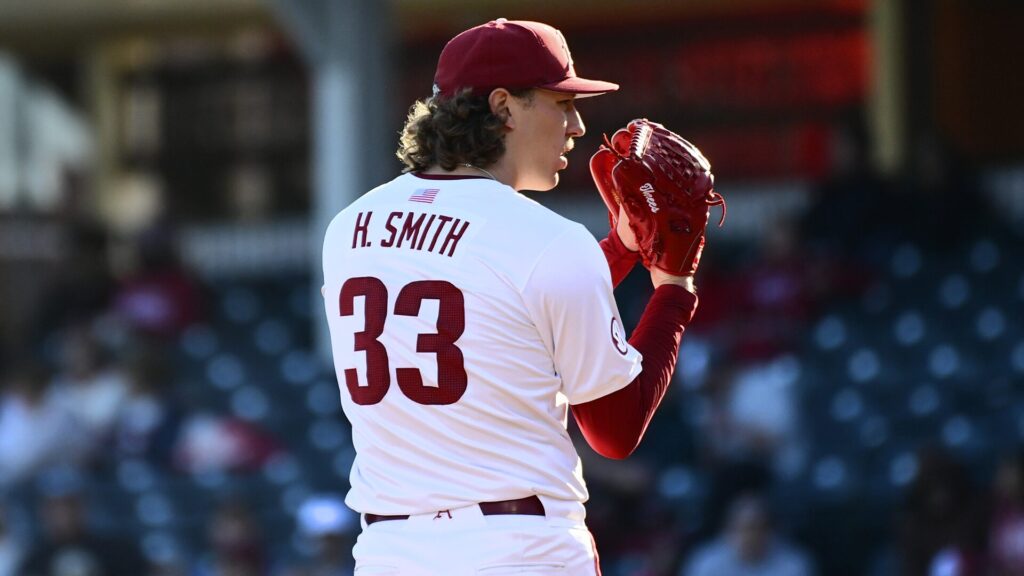
7. Hagen Smith, LHP -- Arkansas
HOMETOWN: Bullard, TX
HEIGHT: 6-3
WEIGHT: 224
BAT/THROW: L-L
DRAFT SPOTLIGHT INTERVIEW: Watch video
Smith famously threw six no-hitters his senior year of high school, completely dominating the competition. That's continued at Arkansas over his collegiate career, slicing and dicing up the competition with flashes of brilliance.
The book on Smith is deception and loud stuff. His delivery makes it extremely difficult to pick up his pitches out of the hand. It's a herky-jerky, full-limbed delivery with moving parts, but that's not to say it's full of effort or that it isn't repeatable. It is. It's just unconventional with uncomfortable angles for the opposition.
Smith throws the kitchen sink. A four-seam fastball, a sinker, a slider, a split-finger, and a very nascent curve. He's primarily a fastball-slider-split guy, though there's pitchability here and a willingness to mix it up when the opportunity calls for it. His fastball has brushed 100 mph in side sessions, however, he more comfortably lives in the 94-97 range and will grab the upper 90s early in games. The real weapon is the splitter, a massive fading parachute that's tormented hitters for the better part of three years. It flashes plus and is consistently an above-average weapon though its consistency has wavered this spring as Smith tends to go to the breaking ball more often.
Smith doesn't spin the ball particularly well, so improving that may be a developmental goal, but he does know how to shape a slider and that pitch too will sit above average and flash plus or better consistently in starts. Smith projects a potential frontline lefty if he can get his control and command of the ball up to more consistent levels. If walks and control/command woes hamper his development his role could get diluted.
There's a lot of Josh Hader in the overall profile here, and whoever drafts him may elect to throw him out of the bullpen quickly in his career and get him to the big leagues sooner rather than later. It's quite clearly a starting pitcher profile, however. The biggest narrative in draft war rooms will be the fact Smith is in year five of his second UCL after going under the knife in high school.















